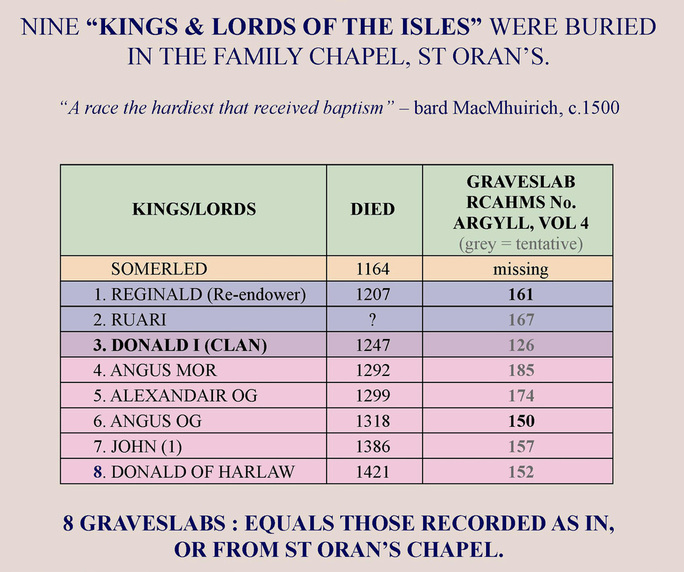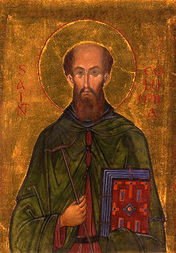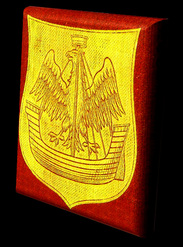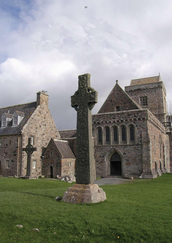ST ORAN'S CHAPEL (TEAMPEALL ODHRAIN ).
Somerled built and was buried, 1164, in his new, mid 12th c. mausoleum, Teampeall Odhrain, ie, St Oran’s Chapel. Historic Scotland date the chapel as c.1150 matching Somerled’s conquest of the Isles. Reginald was only born in c.1153 (died age 54 – G. Buchanan) therefore he could not have built it. It was originally a pre-Columban dry-stone oratory built over St Oran’s grave with the altar over his tomb or translated relics as was the practice (then, only maybe, Queen (St) Margaret’s small effort c.1073). These events are confirmed by both the architectural archaeology and the history. (RCAHMS 1977, 1982; RA McDonald – “Death & Burial of Somerled”).
He was RI INNSE-GALL(King of The Isles) and would demand nothing less than to be buried with the 40 (at least) other Gaelic/Celtic/Norse Kings (or ‘sub-kings’) of Ireland, Scotland and ‘Norway’ in Reilig Odhrain, the most ancient graveyard in all Scotland - in a “Celtic Church” cemetery. And buried right next to the relics of a revered saint (Oran) whose earthly remains were forever in direct contact with his soul in heaven! St Oran was first on Iona, dieing there in 548 of the plague, 15 years before Colum Cille even arrived. [1] W. Reeves even says “St Columba’s bones should be sought for in the Reilig Odhrain”! [2]
[Somerled is not buried in Saddell Abbey (unless his heart is - "heart burial"). The warrior slab, south wall of the choir, Saddell, is 14th century at earliest and the wall niche is 15th.]
______________________________________________________________
[1] AFM 548.7 :- St. Odhran, of Leitrioch Odhrain, died on the second day of the month of October, AD 548. Tiroran –land of Oran on Mull; Kiloran on Colonsay; Oransay, etc). Oran was not in the original 12 who came with Colum Cille. The re-burial ‘legend’ of him is simply a clever disguise of Oran’s prior foundation on Iona – he preceded Columba.
[2] Reeves, William; Adomnan’s Life of St Columba; p.317, f/notes ‘it lies’; 1857.
Somerled built and was buried, 1164, in his new, mid 12th c. mausoleum, Teampeall Odhrain, ie, St Oran’s Chapel. Historic Scotland date the chapel as c.1150 matching Somerled’s conquest of the Isles. Reginald was only born in c.1153 (died age 54 – G. Buchanan) therefore he could not have built it. It was originally a pre-Columban dry-stone oratory built over St Oran’s grave with the altar over his tomb or translated relics as was the practice (then, only maybe, Queen (St) Margaret’s small effort c.1073). These events are confirmed by both the architectural archaeology and the history. (RCAHMS 1977, 1982; RA McDonald – “Death & Burial of Somerled”).
He was RI INNSE-GALL(King of The Isles) and would demand nothing less than to be buried with the 40 (at least) other Gaelic/Celtic/Norse Kings (or ‘sub-kings’) of Ireland, Scotland and ‘Norway’ in Reilig Odhrain, the most ancient graveyard in all Scotland - in a “Celtic Church” cemetery. And buried right next to the relics of a revered saint (Oran) whose earthly remains were forever in direct contact with his soul in heaven! St Oran was first on Iona, dieing there in 548 of the plague, 15 years before Colum Cille even arrived. [1] W. Reeves even says “St Columba’s bones should be sought for in the Reilig Odhrain”! [2]
[Somerled is not buried in Saddell Abbey (unless his heart is - "heart burial"). The warrior slab, south wall of the choir, Saddell, is 14th century at earliest and the wall niche is 15th.]
______________________________________________________________
[1] AFM 548.7 :- St. Odhran, of Leitrioch Odhrain, died on the second day of the month of October, AD 548. Tiroran –land of Oran on Mull; Kiloran on Colonsay; Oransay, etc). Oran was not in the original 12 who came with Colum Cille. The re-burial ‘legend’ of him is simply a clever disguise of Oran’s prior foundation on Iona – he preceded Columba.
[2] Reeves, William; Adomnan’s Life of St Columba; p.317, f/notes ‘it lies’; 1857.
The cult of saints, body part relics, the doctrines of purgatory and intercessory prayer were to profoundly shape their lives, institutions and burial rites.
"depositio ad sanctos"; “Relics were the Saints, continuing to live among men;” "The dead are not actually dead .”
“The Saints could act and feel like the living, and were treated as if they were alive and incorrupt.”
“And I shall be clothed again with my skin, and in my flesh I shall see my God.” (Job 19:26)
DEFINITIVE INTERPRETATIVE FRAMEWORK (from the martyrs onwards).
“The soul in heaven remains in contact with the earthly body, which shall renew itself at the Resurrection, but which is already filled with a heavenly dynammis-virtrus, with a manna-like power. It was a miraculous double existence” (“Treasures of Heaven”; 2011; pps 19-26).
Ancestral graves remain the constant centre of life – the sacred storehouse - a “mode of sepulture, according to the tradition of the country.”
"depositio ad sanctos"; “Relics were the Saints, continuing to live among men;” "The dead are not actually dead .”
“The Saints could act and feel like the living, and were treated as if they were alive and incorrupt.”
“And I shall be clothed again with my skin, and in my flesh I shall see my God.” (Job 19:26)
DEFINITIVE INTERPRETATIVE FRAMEWORK (from the martyrs onwards).
“The soul in heaven remains in contact with the earthly body, which shall renew itself at the Resurrection, but which is already filled with a heavenly dynammis-virtrus, with a manna-like power. It was a miraculous double existence” (“Treasures of Heaven”; 2011; pps 19-26).
Ancestral graves remain the constant centre of life – the sacred storehouse - a “mode of sepulture, according to the tradition of the country.”
|
| ||||||||||||
Your browser does not support viewing this document. Click here to download the document.
|
Attribution of Lord's slabs and positions of burial.
| ||||||
Your browser does not support viewing this document. Click here to download the document.





